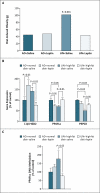Effect of in utero and early-life conditions on adult health and disease
- PMID: 18596274
- PMCID: PMC3923653
- DOI: 10.1056/NEJMra0708473
Effect of in utero and early-life conditions on adult health and disease
Figures





Comment in
-
In utero and early-life conditions and adult health and disease.N Engl J Med. 2008 Oct 2;359(14):1523; author reply 1524. doi: 10.1056/NEJMc081629. N Engl J Med. 2008. PMID: 18832254 No abstract available.
-
In utero and early-life conditions and adult health and disease.N Engl J Med. 2008 Oct 2;359(14):1523; author reply 1524. N Engl J Med. 2008. PMID: 18837129 No abstract available.
-
In utero and early-life conditions and adult health and disease.N Engl J Med. 2008 Oct 2;359(14):1523-4; author reply 1524. N Engl J Med. 2008. PMID: 18837146 No abstract available.
References
-
- Bateson P, Barker D, Clutton-Brock T, et al. Developmental plasticity and human health. Nature. 2004;430:419–21. - PubMed
-
- Barker DJ, Osmond C. Infant mortality, childhood nutrition, and ischaemic heart disease in England and Wales. Lancet. 1986;1:1077–81. - PubMed
-
- Kensara OA, Wootton SA, Phillips DI, et al. Fetal programming of body composition: relation between birth weight and body composition measured with dual-energy X-ray absorptiometry and anthropometric methods in older Englishmen. Am J Clin Nutr. 2005;82:980–7. - PubMed
-
- Hales CN, Barker DJ. Type 2 (non-insulin-dependent) diabetes mellitus: the thrifty phenotype hypothesis. Diabetologia. 1992;35:595–601. - PubMed
Publication types
MeSH terms
Grants and funding
LinkOut - more resources
Full Text Sources
Other Literature Sources
Medical
